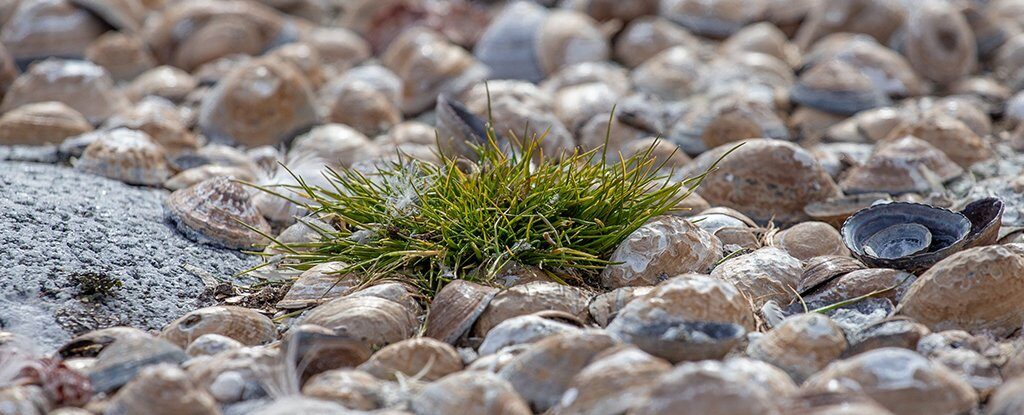A new study of this plant expansion looked at the two flowering plants native to Antarctica, Deschampsia antarctica and Colobanthus quitensis. Researchers measured the growth and expansion of these plants on a small subantarctic island called Signy Island from 2009 to 2019.
Both plants grew faster each year as temperatures rose - which the team puts down to warming summer air and a drop in the plant-trampling fur seal population, which could be down to food availability and sea conditions.
Comment: This study actually conflicts with another that showed summer temperatures have been dropping, and to such an extent that the regions moss forests were declining. That said, even if temperatures were anomalously higher in summer, recent winters have seen record ice growth and cold temperatures; last winter in particular was the coldest on record: Global Warming? South Pole just underwent its coldest 'winter' in recorded history
Further, the reduction in the presence seal population - who may have simply moved to other areas that are more accommodating, with more abundant food sources - may be yet another sign of the overall cooling in the region. A study of Antarctica's Adelie penguins found that they were in fact happier in regions with less sea ice, not more: Antarctica's Adélie penguins happier with less sea ice, research shows ice is growing
"We hypothesize that the striking expansion of these plants is mainly triggered by summer air warming and release from the limitation of fur seal disturbance," write the researchers in their published paper.
Between 1960 and 2011, the air increased by 0.02 degrees Celsius each year, but after a four-year cold snap, it's been increasing at a rapid 0.25 degrees a year.
Comment: Global warming with 'cold snaps'... Indeed, even mainstream science, whose funding mostly relies on finding support for the man-made warming narrative has had to admit that the changes occurring on our planet include significant cooling events: Texas cold snap linked to 40 years of increasing snowfall in Arctic & disruptions in stratospheric polar vortex - increase in extreme cold events likely - study
The growth rate of D. antarctica between 1960 and 2009 was nearly 21 percent a decade. That rate increased to 28 percent a decade from 2009 to 2018. Meanwhile, over the same periods, C. quitensis growth went from just under 7 percent a decade to 154 percent.
Comment: The above confirms what most scientists agree on, which is that our planet did experience a period of warming, because it usually does, just before it enters an ice age. And the reduction in the growth rate from 2009 to 2018 compared to previous decades reflects this trend: Global cooling to replace warming trend that started 4,000 years ago - Chinese scientists
While all this might be good news for D. antarctica and C. quitensis, it's not going to benefit the area as a whole: The warming temperatures may give invasive species a foothold in the ecosystem, one that could cause "irreversible biodiversity loss and changes to these fragile and unique ecosystems," the authors write.
The same sort of plan expansion has been recorded on the mountains of Europe, but this study shows "the first evidence in Antarctica for accelerated ecosystem responses to climate warming," the authors note. It turns out that Antarctica might not be as resistant to the climate crisis as we thought.
"This hypothesis is compatible with observations in the Northern Hemisphere, in particular in Europe, where land use change correlates with vegetation change but, as here, the primary driver of these responses was climate warming," write the researchers.
Comment: And, as noted in the study itself, less seals are visitng the island. Might that be the most signficant factor?
The researchers suggest what's happening on Signy Island is likely to be occurring elsewhere, although further studies will be required to know for sure. More research is also needed about the possible future impacts of the spread.
With so many factors in play, from plant expansion to seasonal rainfall to ice melt, it's a challenge to predict precisely where Antarctica is heading - but it's clear that this is a very delicately balanced environment and one which is under severe threat.
"Our findings support the hypothesis that future warming will trigger significant changes in these fragile Antarctic ecosystems," write the researchers.
The research has been published in Current Biology.




Comment: There is yet another factor to consider, not acknowledged in the above study, which is undersea volcanic heating: Volcanoes melting West Antarctic glaciers, 3 new studies confirm
See also:
- The Seven Destructive Earth Passes of Comet Venus
- Ozone hole above Antarctica is one of the largest ever, it's still growing, and may be linked to the COOLING stratosphere
- Cosmic climate change: 'Space plasma hurricane' observed in ionosphere above North Pole!
- Gulf Stream System at its weakest in over a millennium, last significant decline recorded during the little ice age
And check out SOTT radio's: